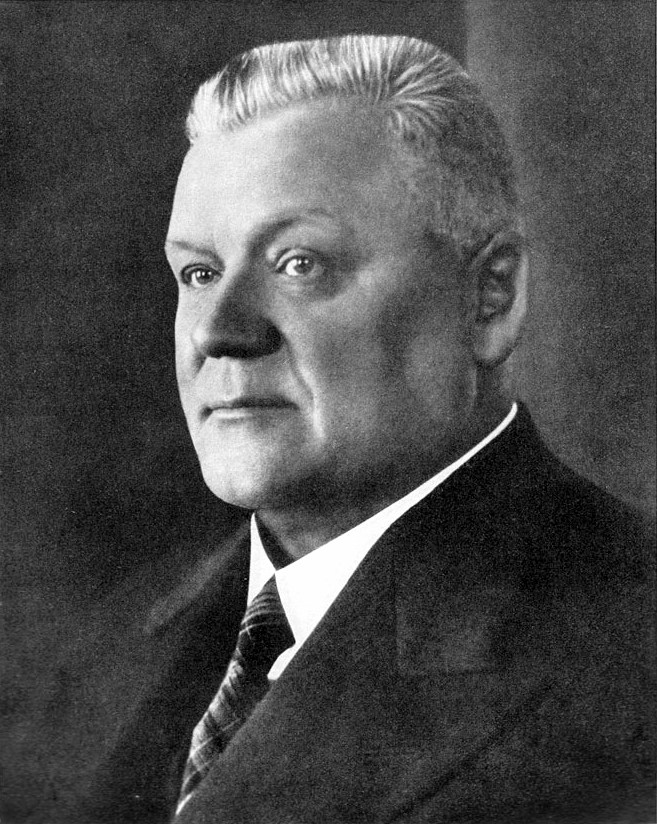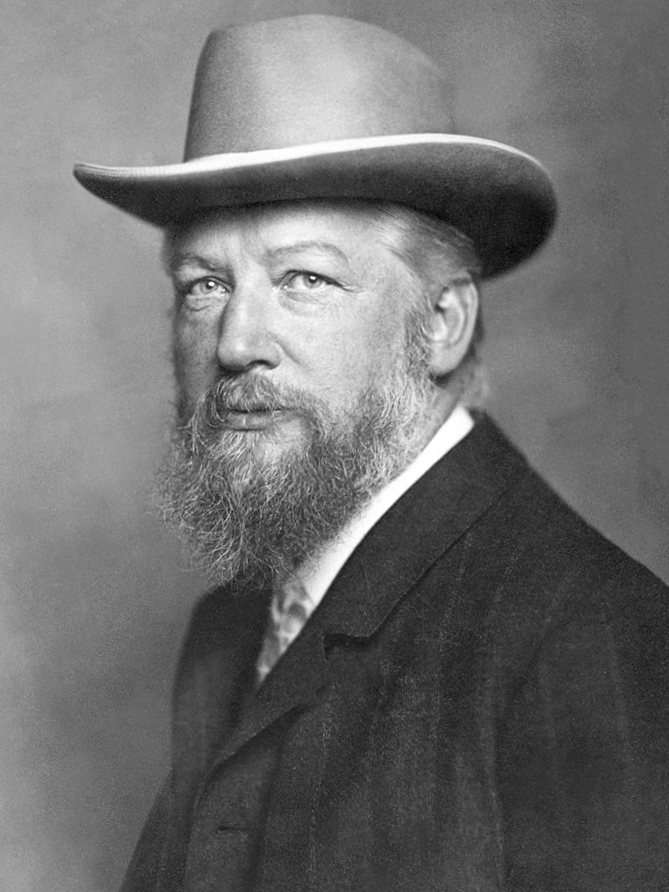|
Zigfrīds Anna Meierovics
Zigfrīds Anna Meierovics (, Durbe – 22 August 1925, near Tukums) was a Latvian politician and diplomat who served as the first Foreign Minister of Latvia from its independence until 1924 and again from December of the same year until his death. He also served two terms as the Prime Minister of Latvia from June, 1921 to January, 1923 and from June 1923 to January, 1924. He was one of the founders of the Latvian Farmers' Union, one of Latvia's oldest political parties. Early life Meierovics was born into the family of a Jewish doctor and his Latvian wife Anna, who died in childbirth. His father became mentally ill and therefore young Meierovics grew up with his uncle's family in Sabile. He studied at the Riga Polytechnicum. Career After 1911 Meierovics belonged to various Latvian organizations, notably the Riga Latvian Society. During World War I he worked in the Latvian Refugee Committee and the organizing committee of the Latvian Riflemen units. After the February Revolu ... [...More Info...] [...Related Items...] OR: [Wikipedia] [Google] [Baidu] |
Prime Minister Of Latvia
The prime minister of Latvia ( lv, ministru prezidents) is the most powerful member of the Government of Latvia, who presides over the Latvian Cabinet of Ministers. The officeholder is nominated by the president of Latvia, but must be able to obtain the support of a parliamentary majority in the Saeima. The tables below display all Latvian prime ministers from both the first period of Latvian independence (1918–1940) and since the country regained its independence (1990–present). From 1990 to 6 July 1993, the head of government was known as the chairman of the Council of Ministers. A direct translation of the official Latvian term is minister-president. Although the equivalent is used in some European languages, it is not used conventionally in English. List 1918-1940 Political Party: 1940-1990 Vilis Lācis, JANIS (VILIS) LACIS (1940-1959) Jānis Peive (1959-1963) Vitālijs Rubenis (1963-1970) Jurijs Rubenis (1970-1988) Vilnis Edvīns Bresis (1988-1990) 1 ... [...More Info...] [...Related Items...] OR: [Wikipedia] [Google] [Baidu] |
Tukums
Tukums (; german: Tuckum; liv, Tukāmō) is a town in the Zemgale region of Latvia. History The historical center of Tukums developed between trade routes leading from the mouth of the Daugava River to Prussia. The oldest part is today's Talsi Street that originated at the river named Zvirgzdupite where there used to be a castle mound with a wooden castle. Since 1253 Tukums was ruled by the Livonian Order. A masonry castle was built on the bank of the Slocene river in the end of the 13th century. The castle was surrounded by settlements of Germans, German tradesmen and craftsmen. A marketplace was formed in front of the castle and some new streets appeared later running in various directions from the marketplace. With the development of trade in the 16th century a new straighter trade route to Prussia was built along a new street that is called Liela (large) Street today which had an important role in the life of the settlement. As a result, public buildings, major business ... [...More Info...] [...Related Items...] OR: [Wikipedia] [Google] [Baidu] |
Tautas Padome
The People's Council of Latvia ( lv, Latvijas Tautas padome, LTP) was a temporary council which declared Latvia's independence on November 18, 1918 and then acted as the temporary parliament of the country until a Constitutional Assembly was elected. The People's Council was formed on November 17, 1918 as a result of merging two councils of Latvian organizations: Latvian Provisional National Council ( lv, Latvijas Pagaidu Nacionālā padome'','' LPNP) and the Democratic Bloc. Originally, the People's Council had 40 members representing all the major Latvian political organizations, except the far right and the far left (communists). It was later expanded to 245 representatives. On November 18, 1918, the People's Council declared Latvia an independent country at the now National Theatre of Latvia. It chose Jānis Čakste as the President of the Council and Kārlis Ulmanis as the Prime Minister of the Latvian Provisional Government The Latvian Provisional Government ( lv, Latvi ... [...More Info...] [...Related Items...] OR: [Wikipedia] [Google] [Baidu] |
Latvian Provisional National Council
Latvian Provisional National Council (, LPNP) was a political organization established on November 29, 1917 (November 16 in the Julian calendar) in Valka, Governorate of Livonia by the Latvian Refugee Support Central Committee, Latvian political parties and representatives from the Provisional Land Council of Vidzeme and the Provisional Land Council of Latgale. Due to German army advances, the National Council also met in Petrograd, in secrecy from the new Bolshevik regime. Creation On October 14–17, 1917, Latvian organizations and politicians met in Petrograd and agreed to create a Council that would include 3 representatives from Vidzeme, 3 from Latgale, 3 from Kurzeme, 2 from the Refugee Support Central Committee, 1 from the Baltic Refugee Organization, 2 from Iskolat, 2 from the Soldiers' Union, 1 from the Latvian Farmers' Union, 1 from left-wing parties and 1 from right-wing of the Latvian Social Democrats, as well as 1 from Eser, Radical Democrat and National Democrat ... [...More Info...] [...Related Items...] OR: [Wikipedia] [Google] [Baidu] |
Congress Of The Peoples Of Russia
The Congress of the Enslaved Peoples of Russia was a congress of representatives of different nationalities to discuss their political situation in the Russian Empire. It was held on in Kyiv, Ukraine. History World War I and the February Revolution brought hopes that the various minorities in the Russian Empire could attain some freedoms. The congress was organized by the Ukrainian Central Rada to discuss these political aspirations and better coordinate their efforts. In total, there were 93 representatives of 20 nations, including Belarusians, Buryats, Georgians, Estonians, Jews, Lithuanians, Latvians, Crimean Tatars, Moldavians, Don Cossacks, and Cossacks. Polish and Finnish representatives did not participate as they had already proclaimed independence. The Russian Provisional Government was represented by Maksym Slavinsky, member of the Constitutional Democratic Party (Kadets). Latvians had ten representatives, including future Prime Minister Zigfrīds Anna Meierovics. Estonia ... [...More Info...] [...Related Items...] OR: [Wikipedia] [Google] [Baidu] |
Riga
Riga (; lv, Rīga , liv, Rīgõ) is the capital and largest city of Latvia and is home to 605,802 inhabitants which is a third of Latvia's population. The city lies on the Gulf of Riga at the mouth of the Daugava river where it meets the Baltic Sea. Riga's territory covers and lies above sea level, on a flat and sandy plain. Riga was founded in 1201 and is a former Hanseatic League member. Riga's historical centre is a UNESCO World Heritage Site, noted for its Art Nouveau/Jugendstil architecture and 19th century wooden architecture. Riga was the European Capital of Culture in 2014, along with Umeå in Sweden. Riga hosted the 2006 NATO Summit, the Eurovision Song Contest 2003, the 2006 IIHF Men's World Ice Hockey Championships, 2013 World Women's Curling Championship and the 2021 IIHF World Championship. It is home to the European Union's office of European Regulators for Electronic Communications (BEREC). In 2017, it was named the European Region of Gastronomy. I ... [...More Info...] [...Related Items...] OR: [Wikipedia] [Google] [Baidu] |
February Revolution
The February Revolution ( rus, Февра́льская револю́ция, r=Fevral'skaya revolyutsiya, p=fʲɪvˈralʲskəjə rʲɪvɐˈlʲutsɨjə), known in Soviet historiography as the February Bourgeois Democratic Revolution and sometimes as the March Revolution, was the first of two revolutions which took place in Russia in 1917. The main events of the revolution took place in and near Petrograd (present-day Saint Petersburg), the then-capital of Russia, where long-standing discontent with the monarchy erupted into mass protests against food rationing on 23 February Old Style (8 March New Style). Revolutionary activity lasted about eight days, involving mass demonstrations and violent armed clashes with police and gendarmes, the last loyal forces of the Russian monarchy. On 27 February O.S. (12 March N.S.) the forces of the capital's garrison sided with the revolutionaries. Three days later Tsar Nicholas II abdicated, ending Romanov dynastic rule and the Russian Empi ... [...More Info...] [...Related Items...] OR: [Wikipedia] [Google] [Baidu] |
World War I
World War I (28 July 1914 11 November 1918), often abbreviated as WWI, was one of the deadliest global conflicts in history. Belligerents included much of Europe, the Russian Empire, the United States, and the Ottoman Empire, with fighting occurring throughout Europe, the Middle East, Africa, the Pacific, and parts of Asia. An estimated 9 million soldiers were killed in combat, plus another 23 million wounded, while 5 million civilians died as a result of military action, hunger, and disease. Millions more died in genocides within the Ottoman Empire and in the 1918 influenza pandemic, which was exacerbated by the movement of combatants during the war. Prior to 1914, the European great powers were divided between the Triple Entente (comprising France, Russia, and Britain) and the Triple Alliance (containing Germany, Austria-Hungary, and Italy). Tensions in the Balkans came to a head on 28 June 1914, following the assassination of Archduke Franz Ferdin ... [...More Info...] [...Related Items...] OR: [Wikipedia] [Google] [Baidu] |
Riga Technical University
Riga Technical University (RTU) ( lv, Rīgas Tehniskā universitāte) is the oldest technical university in the Baltic countries established on October 14, 1862. It is located in Riga, Latvia and was previously known as 'Riga Polytechnical Institute' and 'Riga Polytechnicum'. History Riga Polytechnical Institute (1862–1918) Riga Polytechnicum was first established in 1862 and was the first poly technical institute in Imperial Russia. It offered degrees in agriculture, chemistry, engineering, mechanics, trade and architecture, with education in German. In addition to four technical faculties (architecture, engineering, mechanical engineering, chemistry), the polytechnic also included an agricultural and a commercial faculty. The first lecturers came from Germany, Switzerland and Austria-Hungary. The language of instruction was German. Between 1863 and 1869, the number of students grew from sixteen to ninety. In 1869 the polytechnic moved into a new building. Since there was a l ... [...More Info...] [...Related Items...] OR: [Wikipedia] [Google] [Baidu] |
Sabile
Sabile (; german: Zabeln) is a town in Talsi Municipality Talsi Municipality ( lv, Talsu novads) is a municipality in Courland, Latvia. The municipality was formed in 2009 by merging Abava parish, Balgale parish, Ģibuļi parish, Īve parish, Ķūļciems parish, Laidze parish, Lauciene parish, L ..., Latvia. Sabile was first mentioned in chronicles in 1253. From the 14th century to the 16th century, it was a site of a castle of the Livonian Order and a village near the castle. Sabile became a town in 1917. The Sabile Wine hill ('' Sabiles Vīna Kalns'') used to be the most northern open-air vineyard in the world, registered in the Guinness Book of Records. The winemaking tradition in Sabile dates back to the 16th century. For the first time, wine production was created here during Livonia (14th century), and the hill was completely restored in 1936 during by the mayor Osvalds Rezebergs. The Sabile Castle Mound, which was the center of the district from the 10th centur ... [...More Info...] [...Related Items...] OR: [Wikipedia] [Google] [Baidu] |

.jpg)


